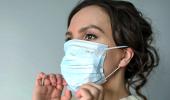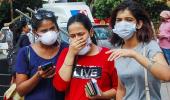'Every time you put on a mask and take the mask off and adjust the fit, you are putting additional fatigue on the materials.'
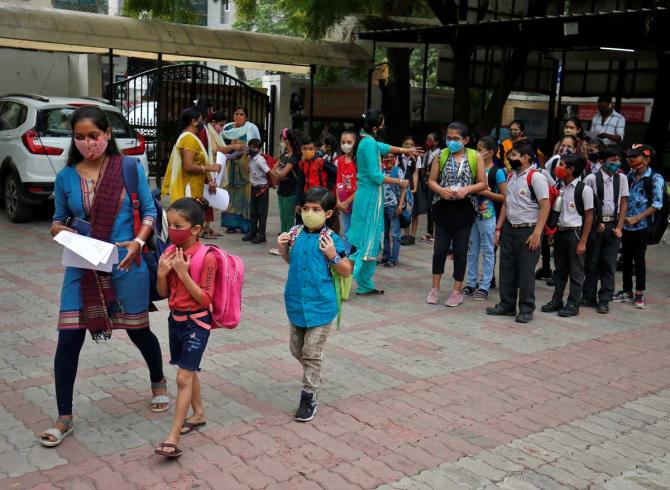
The new potentially highly-transmissible Omicron variant of the coronavirus has once again highlighted the urgency of wearing a mask to avoid transmission of the deadly virus.
How do you choose whether it is safer to wear an N95, a KN95, a surgical mask or a cloth mask every time you leave your home?
Eugenia O'Kelly, who runs the Respiratory Protection Engineering Task Force at the department of engineering, University of Cambridge in the United Kingdom, has diligently, untiringly, spent the good part of 2020 and 2021 looking for those elusive answers on this unique but critical topic in our pandemic-sieged world.
She is something of a mask expert, even if she is careful to frame each of her answers to include margins of error.
Her research group 'addresses critical questions regarding face mask protection in response to the COVID-19 pandemic'.
When the pandemic began, her mom -- a respiratory therapist -- alerted her to the dangers of COVID-19 and provoked her interest in masks.
While O'Kelly herself prefers to wear respirators, her research of masks has shown her that various masks and double masks have their merits, but the merits are reduced considerably if they don't fit properly.
O'Kelly offers Vaihayasi Pande Daniel/Rediff.com sound, solid advice on what mask to wear and more importantly how to wear it.
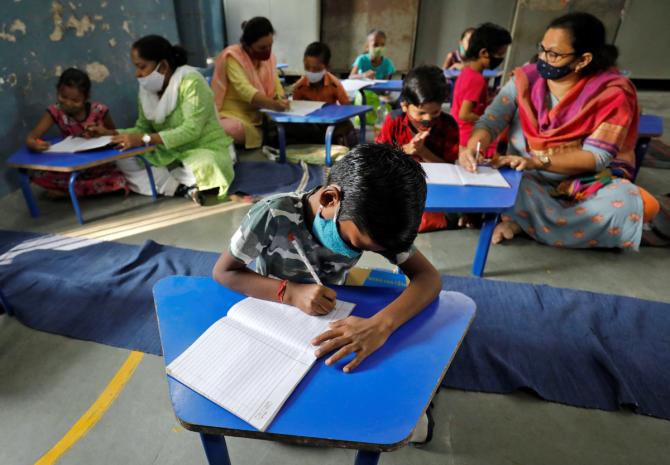
What percentage of transmission of particles will still happen in a well-fitted mask? Broadly speaking, by what percentage does the protection go down by in a not so well-fitting mask?
That's somewhat difficult to answer, because it depends on how poorly fitted the mask is.
If you're looking like where the pass line is, it depends on the test. And a lot of it can't quite be quantified.
For example, in qualitative fit testing, it's not necessarily something that can be quantified -- say like the number of particles that have entered the mask. You could theoretically have someone who is extraordinarily sensitive to a chemical, and you could have fewer particles (entering) but would register as a fail, (compared) to someone who's less sensitive to a chemical, who would register a fail with much greater leakage.
So, it's a bit of an impossible question to answer.
But for a well-fitted mask, percentage of prevention of transmission goes up to 95, as per your paper?
In theory, a mask that is a high-functioning mask, that passes the test, should function above 95. And the studies that we've done, most of the masks have functioned well above 95 -- so more in your 97 to 98 per cent filtration (range).
The material itself is rated to filter at least 95 per cent. It does depend a bit on the material.
But as soon as you have a gap, then you've compromised the material because you have an alternative airflow, so then you're not going to be able to get that through (the mask's) filtration.
Your research is focused on people who have to professionally wear masks, like health workers. How could somebody like me do a fit test at home. I do wear glasses, so that's already one sort of semi fit test, I understand, because if your glasses fog up your mask doesn't fit.
We published an article (Performing Qualitative Mask Fit Testing Without a Commercial Kit: Fit Testing Which Can Be Performed at Home and at Work (external link)) in Disaster Medicine and Public Health Preparedness, which is a major journal, that developed a method that relatively inexpensive, considering most fit testing is over $100. For between $15 and $25 someone can do fit testing at home. It does require purchasing some equipment.
Of course, in terms of the most inexpensive ways, just looking for any gaps. Generally, if you can see a gap in the mask, then it's not certainly not going to function at that level.
We have other studies that are exactly on how big of a gap, but they're not published yet.

In absence of an N95, in your view, if one were to combine a surgical mask with a cloth mask, would one get a reasonably good fit?
We did this study that's still in peer review, so it hasn't passed peer review yet, but we did some experiments.
What we found is that it can be quite effective. I mean, we're not talking N95 levels of protection, but it can be quite effective at boosting protection.
Surgical masks tend to have a poor fit, but good filtration. So, if you pick a cloth mask to put over your surgical mask, that has very good fit, maybe something that's elastic and stretchy, although elastic materials tend not to have very good filtration. But what you're essentially then getting is an external device that will help hold the mask to your face.
Unfortunately, again, and this is from data that is preliminary, we tested the difference between (those) devices whose goal is to move the mask farther away from your mouth, which is more comfortable versus bringing the mask closer to your mouth. And moving the mask further away from your mouth seems to be more likely to make the mask have a poor fit. Whereas if you move the mask closer to your mouth it tends to have much improved performance.

Oh, those little gadgets they sell to put inside your mask to give yourself more breathing room. They don't work?
Yes, we tested those.
I wouldn't recommend those if you are looking for protection.

In India, N95s are quite easily available to anyone. It's kind of expensive for like the average man on the street, because a good brand N95 is about Rs 66 or roughly 65 pence.
Life has gotten so much more complicated with COVID-19, so before you leave home, you have to choose from your shelf which mask to pick up -- an N95 or a surgical mask or a cloth mask.
For what kind of activity should you reserve your N95 for? For a plane ride or a really, really busy place? And you should just sort of alternate the others. I mean, how do you live basically?
I can't tell anyone how they should live. This is a decision people have to make for themselves.
Everyone has their own risk profile in terms of both the activities that they're doing, for example, if it's going on a plane or going to a hospital, but also their own health conditions and their tolerances. Do you have a sick relative at home for whom you have to be extra cautious yourself about just during normal daily activities. Or you don't.
Then there's the situation you are in -- do you have existing health conditions?
I myself lean on the more cautious side and I use high-filtration masks in almost all cases. But I have an elderly relative (at home) and I have pre-existing health issues. For me the added discomfort is just worth the reduction in risk.
It is a matter of being aware of what you can tolerate and whether the added financial burden, and in some cases comfort, is worth it for choosing the N95 masks. I think for a lot of people, an N95 is a good decision, especially if you know that the mask fits you. But again, everyone has to make their own call.
How do you choose a mask, when you're buying a cloth mask?
I don't wear a cloth mask myself. No, no, no.
You know how painters will wear respirators that are they're made out of rubber plastic. I purchased that.

With that little thing (vent) in the corner?
That little thing in the corner is a filter. Filters are not going to help you with COVID-19 because they're built for chemical vapors. But P100 filters are like N100 filters. They filter very small particles.
There are pros and cons to that mask. It's very hard to be heard through. But it is cooler and more comfortable than N95 mask. It doesn't tend to gap as easily. I tend to use that.
Or I'll use surgical masks, which I've modified according to my face shape, if I'm just outside, say walking and if I'm not going to be going into any enclosed spaces. Again, I think I'm probably much more cautious than necessary.
But it doesn't cost me anything. I'd rather fall on the side of being overly cautious.

You said the vent will not prevent COVID-19 from entering...
No, there is a filter that you can attach on.
Respirators tend to have different filters that you can place inside. Let's say you're painting, well your main concern might be fumes and so you need a filter that will neutralise those fumes.
You see people wearing respirators. Most of the time they pick the correct filter, but sometimes they just think any filter will work. But filtering chemicals is different than filtering particles.
In another paper of yours, there was some reference to damp masks.
Another thing one is constantly conflicted about is: How long to keep a surgical mask running? And how long to keep an N95 running?
If you have a cloth mask which is still fine and the elastic is good, should one just keep it going?
If you safely quarantine your used and possibly contaminated mask for let's say for 24 hours or 48 hours, can one just go ahead and reuse it? Those are the things that one puzzles over.
This is a really interesting subject. And reusability is something that I wish we had additional funds (to study it), because there was, I think, a study in Nepal that was done on fabric masks, and it didn't use a standard testing methods. It would be really great to be able to repeat this study. But what it found was that washing the fabric significantly decreased its performance.
And if that is true, then there is a significant concern over the use of fabric masks. They immediately become not financially viable. They probably don't become any more environmentally viable than a surgical mask and this is a question I would really like the funds to be able to answer.
But the from that one study, it's a little hard to judge, because of the way that they performed the study -- it's just a bacterial penetration study and it was done with a lot of uncontrolled variables. It's a little difficult for me to make a firm recommendation that would impact so many people.
In terms of surgical masks, I haven't looked very much at surgical masks in terms of how long you can use one surgical mask, mainly because you tend to get so many of them.
But KN95 masks we have looked at. I don't think we ever published this, but our data shows that they tend to recover quite well from being wet, although over time, you will get a decrease (in efficacy).
There is another study someone did about how many times you can don on and take off a mask, because just putting on a mask will -- even if you don't see it -- will start putting wear on the nose wire and the other materials.
If I'm remembering correctly that it was at about 30 wears that the mask became compromised
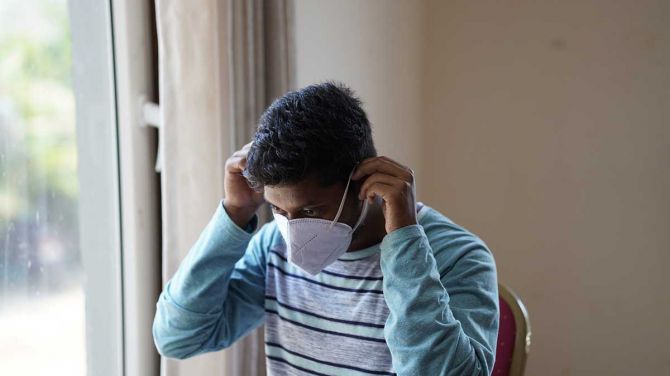
For the KN95s?
The N95s?
30 wears?!
Yes, which is higher than what one might expect. And I'd have to go and check it to be 100 per cent sure of the numbers. Again, that one's not my research, it's someone else's. I was surprised. It's promising.
Of course, that's just a rule of thumb, it would depend on how well designed the mask is, the person and how much deformation the mask is exposed to.
When you're talking about engineering, and you're talking about the wear on any sort of product -- probably one of the greatest error types is fatigue errors.
For example, if you have a light bulb, and you never turn it off, it will burn a lot longer than a light bulb that you're turning on and off, on and off, on and off. Because every time you turn it on and off, you're stressing the filament, and what will happen eventually is that the filament will burn out and that it will burn out faster because of all the additional stress that you have put on it.
Now it's the same thing with a mask, whether it be the elastic, the nose wire, the fabric, although I'm guessing the fabric is a little more resistant to deformation, I couldn't say for sure. Every time you manipulate that mask, it's going to slowly be putting stress. If you put the mask on, and you never took it off, it would actually probably last longer than taking it on and off. But you have to take it on and off.
So, the total number of hours you wear a mask -- and this is just my hypothesis, going by the other research I've seen -- certainly has an impact. Because it changes how wet the mask gets, how much wear it has, how many times you put the mask back on and mold it to your face is going to also have a real impact. As is how severely you have to mould it to your face, so your face shape will have an impact too just because of general material fatigue.
 IMAGE: Eugenia O'Kelly. Photograph: Kind courtesy Eugenia O'Kelly
IMAGE: Eugenia O'Kelly. Photograph: Kind courtesy Eugenia O'KellyI recently used a mask on a long-haul flight. So based on what you just said, I should have changed masks in between.
No, not necessarily. All I'm saying is every time you put on a mask and take the mask off and adjust the fit, you are putting additional fatigue on the materials.
But wearing a mask on a long-haul flight would make it more damp?
Yes that's true.
So therefore, that's one reason to change it?
Yes, I could see the benefit of that.
On the other hand, by taking the mask off, you're increasing the chance that you're going to contaminate your hands or inadvertently expose yourself.
I just don't have the data to say what is the right or what would be the safest move in that case.
Kindly note all images have been posted for representational purposes.
Feature Presentation: Ashish Narsale/Rediff.com
